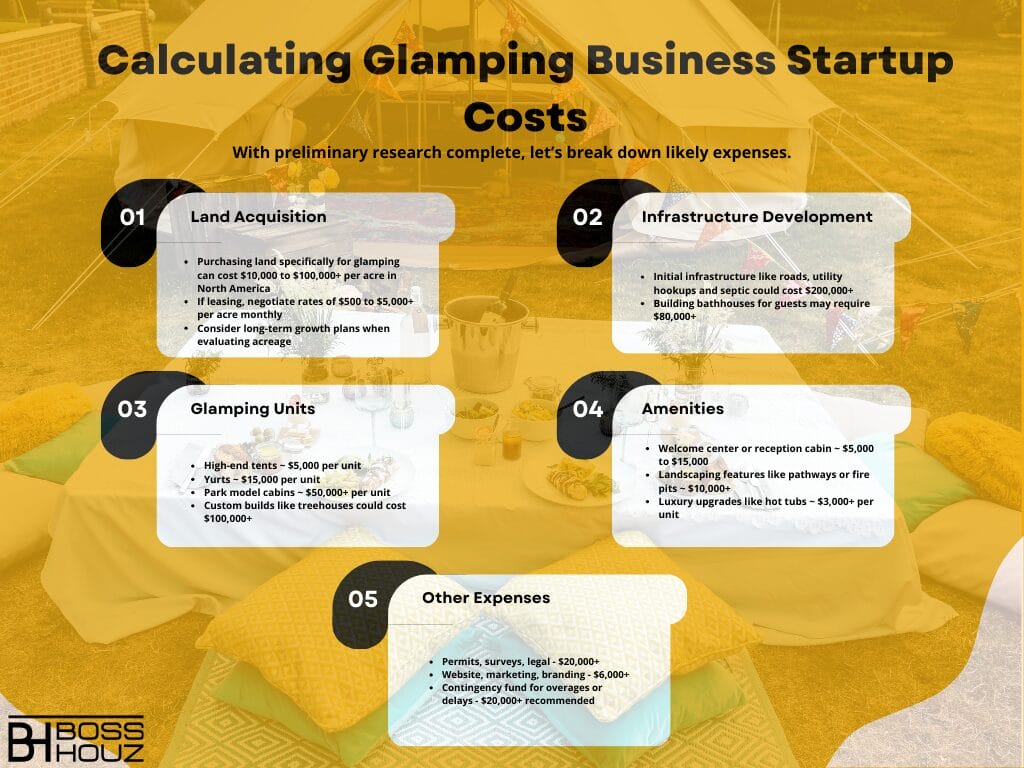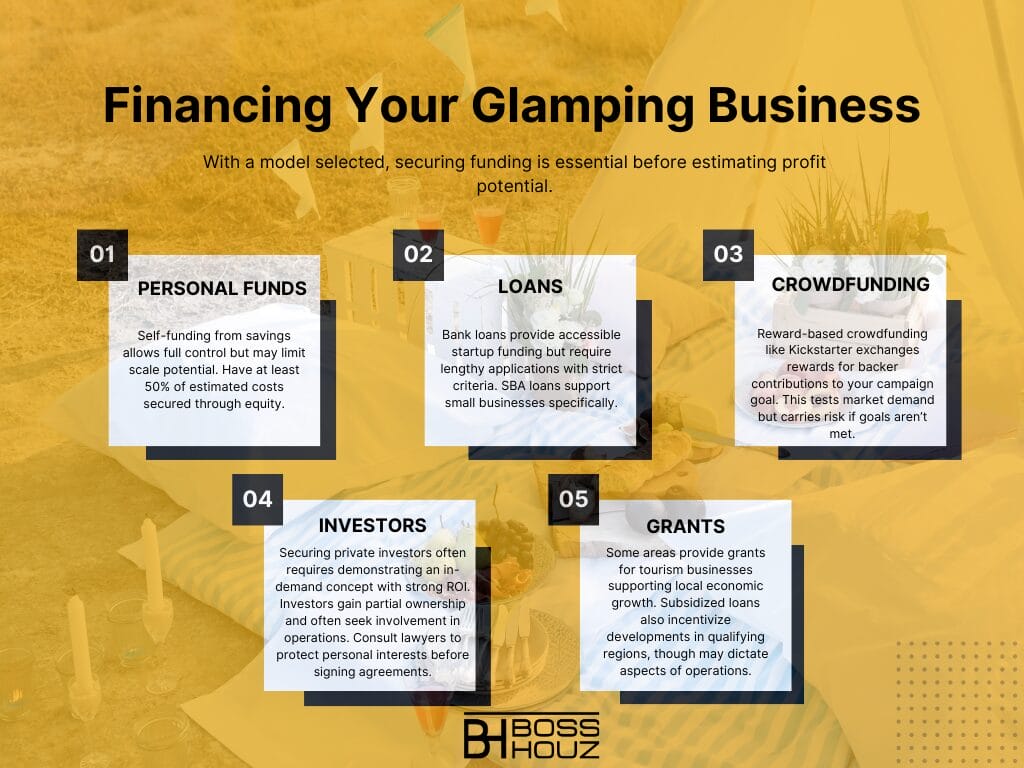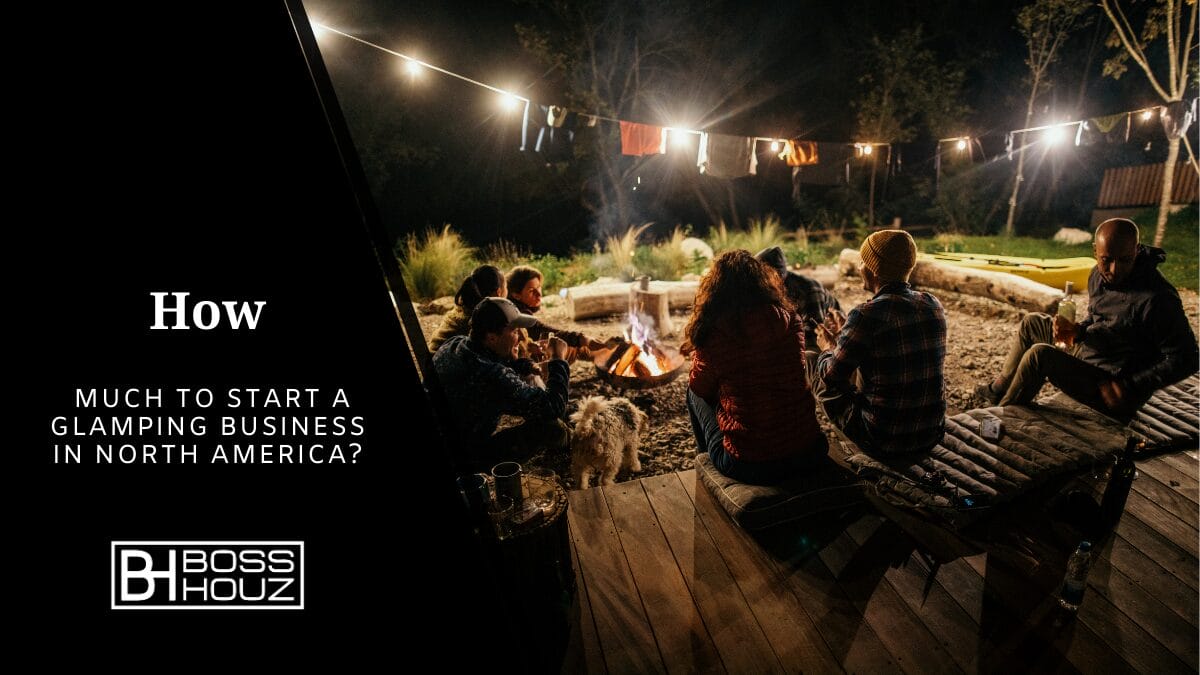Glamping, or luxury camping, has become an increasingly popular trend in the North American hospitality industry. This unique combination of nature and comfort appeals to modern travelers seeking beautiful outdoor settings with upscale amenities. As interest in experiential lodging rises, starting a glamping business presents an exciting and potentially lucrative opportunity.
But like any new venture, launching a glamping site requires careful planning and consideration of all costs and operational factors for success. This comprehensive guide covers everything you need to know, from market analysis to future projections, to start a thriving glamping business in the US, Canada or Mexico.
Table of Contents
Understanding the Glamping Business Landscape

Before calculating startup budgets, it’s essential to understand the current glamping industry.
Glamping Defined
Glamping provides guests luxury accommodations like fully-equipped tents, yurts or cabins in natural settings with upscale facilities like king-sized beds, private bathrooms and high-end furnishings. It merges the rustic appeal of camping with the comforts of a boutique hotel.
The term “glamping” blends “glamorous” and “camping” and has increased in popularity since appearing around 2005. Demand continues to rise.
The Glamping Market
In North America, the glamping market share is predicted to grow by $2.8 billion from 2022 to 2026. Much of this growth comes from rising consumer demand as the trend gains traction through social media and travel influencers.
Rising interest in sustainable tourism also contributes growth for eco-conscious glamping businesses.
Preliminary Considerations
Before estimating exact figures, new entrepreneurs should examine their own readiness as well as legal obligations for glamping businesses.
Personal Readiness
Launching a hospitality venture like glamping demands extensive commitment. Be prepared for high initial time and monetary investments before turning profits. Have a clear vision of your ideal guest experience and what makes your business stand apart.
Legal and Zoning Research
Regulations for glamping businesses vary by state, county and municipal ordinances. Thoroughly research all licenses, permits, zoning restrictions, land-use and lodging laws for your prospective location before estimating costs.
Consulting local government agencies can clarify requirements. Also research building codes and accessibility laws if constructing permanent structures.
Site Selection
Choose sites with natural beauty, recreational appeal and proximity to existing tourist destinations or infrastructure like wineries, national parks and restaurants. If selecting remote locations, ensure accessibility is still convenient for deliveries and emergency services.
Calculating Glamping Business Startup Costs

With preliminary research complete, let’s break down likely expenses.
Land Acquisition
- Purchasing land specifically for glamping can cost $10,000 to $100,000+ per acre in North America
- If leasing, negotiate rates of $500 to $5,000+ per acre monthly
- Consider long-term growth plans when evaluating acreage
Infrastructure Development
- Initial infrastructure like roads, utility hookups and septic could cost $200,000+
- Building bathhouses for guests may require $80,000+
Glamping Units
- High-end tents ~ $5,000 per unit
- Yurts ~ $15,000 per unit
- Park model cabins ~ $50,000+ per unit
- Custom builds like treehouses could cost $100,000+
Amenities
- Welcome center or reception cabin ~ $5,000 to $15,000
- Landscaping features like pathways or fire pits ~ $10,000+
- Luxury upgrades like hot tubs ~ $3,000+ per unit
Other Expenses
- Permits, surveys, legal – $20,000+
- Website, marketing, branding – $6,000+
- Contingency fund for overages or delays – $20,000+ recommended
So for a 10-unit glamping site with high-end amenities and marketing, total costs often range $550,000 to $850,000+. And this doesn’t account for ongoing operational expenses once opened.
Glamping Business Models and Cost Comparisons
Within the luxury camping segment, various models exist. The best type for new entrepreneurs depends on their budget and vision.
Luxury Tents and Yurts
Tents and yurts can provide glamping on a budget.
Costs
- 10 units – $140,000 to $180,000
- Infrastructure – $80,000 to $150,000
- Land fees or financing
- Permits, website, etc.
Pros
- Lower startup costs
- Easier to add units later
- Transportable structures
Cons
- Less stability in poor weather
- More wear and tear over time
- Limited customization
Tiny Houses and Treehouses
Tiny homes or treehouses offer uniqueness through customization.
Costs
- 10 custom units – $500,000+
- Infrastructure – $200,000+
- Land fees or financing
- Permits, website, etc.
Pros
- Unique and Instagrammable
- Integrate sustainability initiatives
- Draw media attention
Cons
- Much higher startup costs
- Permanent structures limit flexibility
- Require high occupancy to profit
Themed Accommodations
Themed glamping uses customized units, decor and specialized services to transport guests, like a safari or medieval castle.
Costs
- 10 themed units – $550,000+
- Extensive customization and landscaping
- Costumes or special equipment
- High marketing budget
Pros
- Stand out as a destination
- Enhance guest experience
- Attract events or groups
Cons
- Niche concept limits audience
- Risky investment in unknown theme
- Complex to execute properly
As shown, startup expenses and risks vary widely. Research multiple models before selecting based on budget and capabilities.
Financing Your Glamping Business

With a model selected, securing funding is essential before estimating profit potential.
Personal Funds
Self-funding from savings allows full control but may limit scale potential. Have at least 50% of estimated costs secured through equity.
Loans
Bank loans provide accessible startup funding but require lengthy applications with strict criteria. SBA loans support small businesses specifically.
Crowdfunding
Reward-based crowdfunding like Kickstarter exchanges rewards for backer contributions to your campaign goal. This tests market demand but carries risk if goals aren’t met.
Investors
Securing private investors often requires demonstrating an in-demand concept with strong ROI. Investors gain partial ownership and often seek involvement in operations. Consult lawyers to protect personal interests before signing agreements.
Grants
Some areas provide grants for tourism businesses supporting local economic growth. Subsidized loans also incentivize developments in qualifying regions, though may dictate aspects of operations.
Thoroughly explore all options before settling on the best financing plan for your capabilities and risk tolerance. This determines how much personal equity you need to begin funding startup costs.
Design and Amenities
Glamping businesses rely on delivering exceptional guest experiences through mindful design choices and amenities.
Site Layout
Strategically map out glamping unit placements for guest privacy while encouraging socialization at key areas like welcome spaces, restaurants or activity zones.
Incorporate area attractions through trails, lakeside accommodations or stargazing spots.
Eco-Friendly Practices
Implement sustainability initiatives like solar power, responsibly sourced build materials, on-site organic gardens or farm-to-table dining.
Eco-friendly efforts attract environmentally conscious travelers while reducing long-term overhead costs.
Amenities
Provide basics like Wi-Fi, mini-fridges, high-thread count linens and elevated bath products. Then customize with glamping-specific upgrades:
- Outdoor showers or soaking tubs
- Firepits, hammocks and porch swings
- Shared community spaces for guest events
- Telescopes for stargazing
Also cater to accessibility, children’s needs, group events or pets to serve broader demographics.
Thoughtful design and amenities tailored to your hospitality vision draw more guest interest and bookings over generic accommodation options.
Marketing Your Glamping Business
An exceptional product means little without marketing to drive visibility and bookings.
An effective website with strong visuals and easy booking functionality is vital. Utilize SEO best practices like meta descriptions for discoverability.
Promote across social media channels with lush photography and special offers. Provide video tours showcasing unique amenities.
Consider paid advertising through Google, Instagram and Facebook to reach target demographics.
Influencer Partnerships
Gifted stays for travel bloggers and influencers in exchange for exposure and reviews builds credibility. Target influencers matching your brand style and audience.
Experiential Partnerships
Offer packages bundling your glamping stay with area attractions like wine tours, hot air balloon rides or couples massages. These incentivize longer bookings.
Creative marketing provides a steady pipeline of reservations to offset initial investments. Reinvest a portion of profits into testing additional digital marketing and partnership initiatives.
Operational Considerations
With the glamping site built and marketed, focus shifts to daily operations.
Staffing
Hire hospitality-experienced managers to oversee daily procedures and guest services along with housekeeping, maintenance and culinary teams if operating an on-site restaurant.
For boutique sites under 20 units, small teams with cross-trained roles may suffice. Those with over 30 units often require 10+ dedicated staff.
Management Software
Invest in reservation and channel management software like NewBook or Rezdy for centralized booking, calendar syncing across online travel agencies like Airbnb, and automated messaging with guests. This maximizes revenue.
Maintenance
Preventative unit maintenance preserves glamping investments for maximum rental potential. Provide housekeeping resources to maintain luxury standards. Keep amenity spaces like pools, trails or gardens well-kept.
Customer Service
Deliver exceptional service through every guest touchpoint, from thorough pre-stay communication to personalized welcome gifts or gestures upon arrival.
Solicit guest feedback for continuous improvement opportunities to exceed expectations. This strengthens brand reputation and loyalty.
Overcoming Challenges
Understanding common obstacles helps new glamping owners plan solutions:
Seasonal Slow Periods
Attract off-season visitors through bundling with area ski resorts or winter activity rentals. Or offer deeply discounted stays during spring or fall for extra income between peak summertime reservations.
Guest Cancellations
Implement non-refundable deposit policies while providing trip insurance options to protect lost income from last-minute cancellations beyond your control.
Unpredictable Costs
Pad initial budgets with contingency funds to absorb unforeseen delays or expenses. Have accessible capital reserves to adapt and pivot if certain offerings underperform.
Scaling Too Quickly
Focus on perfecting operations for current inventory before expanding. This ensures consistent quality and service to fuel organic growth through word-of-mouth.
The Future of Glamping Businesses
The North American glamping industry expects to continue growing up to 15% annually as the blended travel concept gains recognition and popularity.
Projected Trends
Industry experts forecast increasing demand for:
- Custom-built tiny homes over tents
- Eco-friendly sustainability practices
- Glamping sites as wedding and event venues
- Packages bundling glamping with experiences
- Pet-friendly amenities
Preparing for Growth
Savvy glamping entrepreneurs will capitalize on these trends through:
- Focusing initial financing to enable expansion capabilities
- Choosing sites accommodating future additions or tiny home clusters
- Testing pop-up wedding or event offerings before investing in permanent amenities
- Building strong local partnerships ahead of time
- Welcoming pet family bookings with designated cabins
This future-proofing of operations allows glamping businesses to better react to emerging preferences.
Wrapping Up: How to Start Your Glamping Journey
The glamping industry provides an exciting business opportunity as travelers seek transformative nature-meets-luxury experiences. But as with any hospitality venture, success rests on thoughtful planning and financial readiness.
Ensure your concept has clearly defined vision and differentiation. Seek locations encapsulating your hospitality goals while allowing for future expansion possibilities.
Understand all legal and permitting obligations before leasing or buying land to accurately estimate budget needs. Vet financing options and secure startup capital from savings, loans or investors.
Create immersive guest experiences through considered design choices, bespoke amenities and local partnerships. Market visually on digital platforms for maximum visibility and bookings to offset investments. Deliver consistent and exceptional service to build reputation and loyalty.
While launching a thriving glamping business has challenges, the financial upside and lifestyle rewards prove well worth the effort for those with the dedication and creativity to excel in this growing niche.








